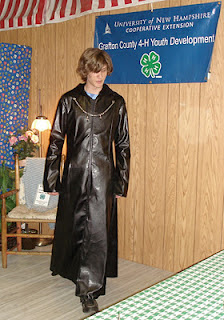native of Haverhill, Capt. Jacob Leroy Bell (1839-1916), who enlisted as a private in the
11th NH Volunteers in 1862 at age 22. Two years later he advanced to the rank of
Captain. Family tradition holds that the desk was made for him by the men in his
Company and that it was used to hold Company records. After seeing service at Spottsylvania, Cold Harbor and Petersburg, Captain Bell retired to Haverhill and kept store at his family home, the Montgomery House at Oliverian Brook. (See earlier posts on the General Montgomery home and Store.) The desk descended in the family and was returned to Haverhill by Capt. Bell's grand-niece, Winifred Merrill Howard of Hartford, CT in 1960.
Upon recent inspection, the desk was found to be in very good condition, and despite, its
portable nature, shows little signs of wear. The front of the desk opens to reveal a series of drawers and dividers. Two confederate bills were also found within the desk. While the
painting on the front of the desk is unsigned, it is possible to speculate that the work was
completed by one of the members of his company. It depicts soldiers and a watchtower in
an cleared field.
The writing desk is on view at the Haverhill Historical Society Museum, Court Street, as
part of commemoration of the 150th anniversary of the Civil War.
Hours: Wednesday and Sunday from 2:00-4:00.
For more information about the HHS, see www.HaverhillHistoricalSociety.blogspot.com
Posted by KSA and AYM




































.jpg)
.jpg)
.jpg)








